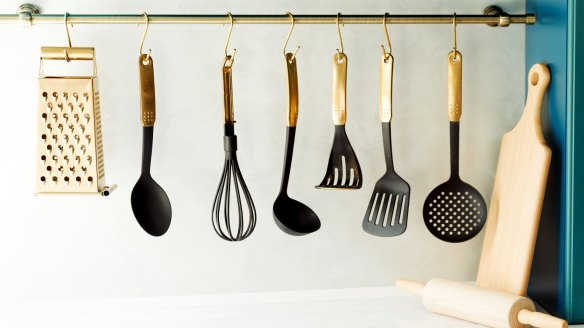How to declutter your kitchen

Some people can live with a messy home office or a disorganised wardrobe, and it doesn't affect their lives in any fundamental way. But the kitchen is different. We all have to eat. If the kitchen is a mess, it can have a real impact on your lifestyle.
If you're not inspired to cook because you can't easily find the tools you need, or if you're convinced you don't have ample space to prepare a meal, not only will your emotional and physical health be affected, but the endless takeaway orders can also kill your budget.
I consulted with kitchen organisation expert Katherine DiGiovanni to develop these recommendations for maximising your storage space and making your kitchen work for you.
1. Take stock and cull the clutter
First, take a complete inventory of your kitchen. Pull everything out of the cabinets and drawers and put back only the items you need and use. Less is more. Why? There are tools that every kitchen needs, but if you have too many gadgets and dishes crowding your cabinets and drawers, it makes accessing them difficult, which means you'll never use them. It's better to stick with the basics and store things so that they're easy to access.
Instead of having a dozen red and white wine glasses, 18 water glasses, four martini glasses, six champagne flutes and 10 mugs crammed into one cabinet, pare down your glassware.
Store the items you use daily within reach of the sink and dishwasher, and donate the extras or store them elsewhere. Likewise, you probably don't need one drawer dedicated to tea towels and another for oven-gloves. Six tea towels and two oven-mitts are probably sufficient and can fit into one drawer.
2. Kitchen helpers
There are several MVP products for organising any kitchen, but in small kitchens these items can make a big difference.
Cabinets: To make things like spices, cooking oils and baking decorations easy to see and grab in your upper cabinets, use a riser or a lazy Susan. Don't be afraid to adjust shelves to make things easier to reach, if necessary. It's not as hard as it looks and can make a big difference.
Installing pull-out drawers in cabinets will help maximise space for things like storage containers or tea towels and will also work well on deep shelves so that food stored in the back isn't forgotten. Clear tubs help corral similar items and are great for keeping bags of rice, pasta, chips and biscuits upright.
When storage is especially tight, consider hanging your most frequently used pots and pans on a hanging pot rack. Pot racks come in two varieties, wall-mounted and ceiling-mounted, and can help free up a lot of real estate in your lower cabinets. In fact, whenever you're in need of space in a kitchen, look up – are there places up high to put shelving or hooks?
Pantry and fridge: Look for versatile organisational products such as Mason-style jars, which are easy to clean, or stackable clear plastic containers. And if you're tight on pantry or cabinet storage for dry goods, large jars filled with red lentils or pasta can double as decor.
Drawers: Drawer dividers can be used in shallow drawers to make measuring spoons, a meat thermometer, a can opener, a corkscrew, tongs and knives easy to find and put away.
3. Saving bench space
Benchtops, free of clutter, are utilitarian and aesthetically pleasing. Don't store rarely used appliances on the counter just because it seems difficult to put them away. The items that stay on your benchtop should be those that you use frequently, such as a toaster or coffee machine. So unless you're a die-hard baker, you probably shouldn't be wasting valuable real estate with a stand mixer. Hand-held beaters will do just fine – and be much easier to store.
If you're short on drawer space, use one benchtop canister for the six utensils you use most often when cooking.
Be sure to make use of wall space. Most knife blocks take up significant bench space; knives can be stored more efficiently in a drawer or on a magnetic strip attached to the wall. And by the way, you don't need 12 different knives. Splurge on three or four good knives (for instance, a chef's knife, a serrated paring knife and a serrated bread knife), and that's all you need. Magnetic strips can also hold small containers of spices, saving valuable cabinet or drawer space.
If your upper cabinets are mounted high enough above your benches, you can even store stemmed wine glasses underneath.
Last but certainly not least, what to do with those large cutting boards? If you have a large wooden cutting board, you might be able to lean it upright against the splashback. The wood can create a little warmth in an otherwise stark kitchen and will still be easy to access when you need it.
You can also place it on top of the fridge, where it's out of sight but still easy to grab. If you opt for a collection of smaller, plastic cutting boards, they can usually be hung on a hook for a fun splash of colour or slid underneath tea towels or oven mitts in a drawer.
Don't buy into the idea that you need a large, elaborate kitchen to cook tasty meals. A small but well-organised kitchen can be just as functional and – bonus – requires less cleaning.
The Washington Post
The best recipes from Australia's leading chefs straight to your inbox.
Sign up- More:
- Home and design